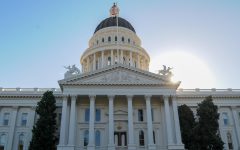
State Capitol. (Photo: Kevin Sanders for California Globe)
Frequently Asked Questions about California Bond Measures
What is the collateral used with a GO bond?
By Chris Micheli, November 29, 2023 2:55 am
What is a definition of a bond fund? According to the Department of Finance (DOF), a bond fund is used to account for the receipt and disbursement of non-self-liquidating bond proceeds.
Who pays for the bonds? According to DOF, depending on the provisions of the bond act, either the General Fund or a special fund pays the principal and interest on the general obligation bonds.
What is a revenue bond? Broadly defined, a revenue bond is a type of municipal bond that is repaid by the operating revenues of the public entity.
Who uses revenue bonds? Revenue bonds are primarily utilized by government entities to subsidize infrastructure projects.
Who guarantees a revenue bond? The financial obligation is primarily guaranteed by the operating revenues. Assets (e.g., the infrastructure project) are used as collateral for the bond (i.e., the loan).
What does “G.O.” stand for in a GO bond? It means general obligation (i.e., an obligation of the state or local government).
What is a GO bond? A general obligation bond (GO bond) is a municipal or state bond measure that is backed by the good faith and credit of the issuing state or local entity.
What is the source of funds for a GO bond? These bonds are based upon the taxing authority of the issuing governmental entity, rather than from the revenues from a project.
What is the collateral used with a GO bond? Assets are not used as collateral. GO bonds are premised on the debt obligation being repaid through taxation or other revenues of the government entity.
Are bond measures submitted to the voters? Some are. For example, bond measures proposed by a local or state entity when the security for the bond would constitute a lien on the property for ad valorem taxes within the jurisdiction.
When a bond issue goes to the ballot, what must be provided to the voters? A statement must be mailed to the voters with the sample ballot for the bond election. the statement must contain specified information, including the best estimate for average annual tax rate, highest tax rate, and total debt service. It also has to contain a declaration of policy of the legislative or governing body, as well as a statement of tax rate data.





Not very helpful. Taxpayers back bonds — not the “state” nor “local government”. It all comes back to taxpayers paying these things off. The “state” is nothing more than the collective voice of individual voters and tax payers.
Either we pay for these bond directly in sales tax increase, or property tax increases, or carving out what is due from our various forms of income taxes, use taxes, etc, fees etc. Some are valuable investments that return benefit to taxpayers. Many are diluted since both tax payers and non-taxpayers benefit. And some are badly misguided shell games because government employees have taken more than their fair share, and left us to fill in the gaps at our own expense.
Fiscal extortion takes place when legislators demand tax payers fund roads and infrastructure with additional bond issues, because all the other tax revenues went to pay off government employee union demands for themselves.
Elect only fiscal conservatives and not tax and spend leftists. Too many people with their hands out along the bond issue food chain, when you chose to finance the present with very expensive long term public debt.